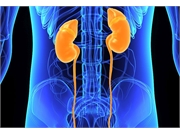Interstitial fibrosis/tubular atrophy, larger cortical nephron size, smaller medullary volume predict failure
FRIDAY, Jan. 24, 2020 (HealthDay News) — Structural features of kidneys from living donors may predict death-censored graft failure in recipients, according to a study published online Jan. 23 in the Journal of the American Society of Nephrology.
Naim Issa, M.D., from the Mayo Clinic in Rochester, Minnesota, and colleagues examined donated kidney features as predictors of death-censored graft failure at three transplant centers using computed tomography and implantation biopsy. Data were analyzed from 2,293 donor-recipient pairs.
The researchers found there were 287 death-censored graft failures and 424 deaths during a mean recipient follow-up of 6.3 years. Independent of both donor and recipient clinical characteristics, factors that predicted death-censored graft failure included interstitial fibrosis/tubular atrophy, larger cortical nephron size (but not nephron number), and smaller medullary volume. Arteriolar hyalinosis also predicted death-censored graft failure in a subset with 12 biopsy section slides.
“We think that these subtle features in the living donor kidney make the recipient more susceptible to lose the kidney transplant over time,” Issa said in a statement. “These important findings may provide insights into previously unrecognized predictors of kidney transplant failure in recipients.”
Copyright © 2020 HealthDay. All rights reserved.








